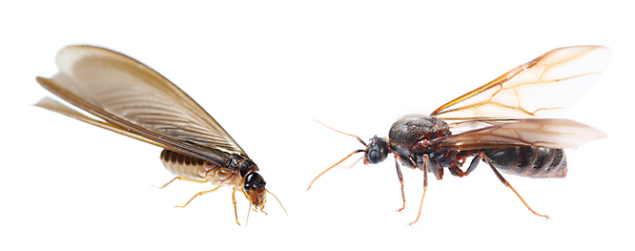Since it is a fact that all the insects hibernate themselves during winters and as soon as the spring season arrives they come out of their hiding spaces and roam around in search of food, and warm and cosy environment. Insects love to live in hot climatic regions and therefore their reproduction efficiency will improve during this season till the end of fall.
Similarly, winged ants and winged termites may become your unwanted guests right after winter, and peeking for any warm and cosy corner in your house or maybe in search of their food. They are very small and live in the form of large colonies, and you may find them very disturbing.
What are Winged ants vs. Winged termites?
Most of the ants and termites are wingless but at some times of the year, you may see them swarming of flying termites and flying ants. These winged termites and winged ants are called alates, which means reproductives or swarmers. Usually, alates are female species of termites and ants and their basic purpose is to mate with the male species and produce their off-springs and make new colonies.
Since they both look somewhat similar, therefore people often confuse them both, but they are very different from each other. Both of them need different types of infestation, so it is necessary to know which one of them has invaded your house.
Winged ants vs. Winged termites Identification
Winged ants and termite ants are very similar to each other in appearance. They both have wings and are black in colour. But you can easily distinguish between both of them and there is expertise required for this.
● Antenna
If you closely examine the antenna of the winged ant then you may notice that the antennae of the winged ant are bent whereas the antennae of the winged termite are perfectly straight.
● Body
All the insects are made up of three distinct body regions, namely head, thorax and the abdomen. Some insects are made up the same length of the three regions and one of them is the winged termite. On the other hand, the head, thorax and abdomen are of different lengths.
●Wings
Both the winged termite and a winged ant have two pairs of wings. One pair of wings is at the front and the other pair of wings are at the back. The front and back pair of wings, in winged termite, are of the same length.
On the other hand, the length of both pairs of wings in winged ant, are different in length. The front wing pair is larger in length than the lateral pair of wing.
Winged ants vs. Winged termites Lifecycle
The lifecycle of winged ants or carpenter ants began with the nuptial or mating flight. After mating the female carpenter ant shed her wings and the male specie dies. The female then searches for a proper place where she can lay her eggs without any threats of predators, and build her colonies. She might use a small wooden crack or hole for this purpose, and also hides inside that hole until the arrival of the new adult. She uses her stored fat reserves and wing muscles as food. An egg of the carpenter ant takes about 6 to 12 weeks to transform into an adult.
The lifecycle of the winged termite also begins with a mating flight just like the winged ant. Similarly, after the mating flight, the female shed her wings and lays her eggs inside an optimum space for reproduction. The difference in the lifecycle of both the insects is that the male specie of the winged termite does not die after mating whereas the male specie in winged ant does.
The reproduction of the winged termite is the same as that of the winged ants, despite the fact that both the male and female winged termites run their colonies as king and queen, and they have a lifespan of about one to two years.
Winged ants vs. Winged termites Control
Winged termites and winged ants are known to be very irritating for homeowners. Both the insects are similar in many aspects but their infestation is completely different. You cannot end up killing both of them with a single trap.
Fill a spray with 1:2 ratio of liquid soap and water and add a few drops of oil in it. This will kill all of them. While for termites, it is better to seek professional help for permanent removal of winged termites or you can also remove the object in which they have invaded.




“Fill a spray with 1:2 ratio of liquid soap and water and add a few drops of oil in it. This will kill all of them.”… what kind of oil? Clarify please and then what do you do with this concoction? Spray points of entry? The ants directly? The nest? Please Clarify